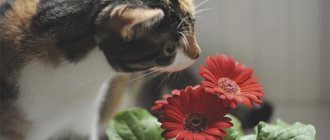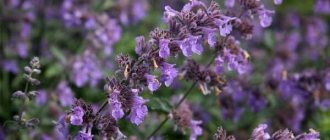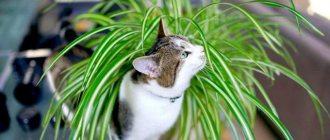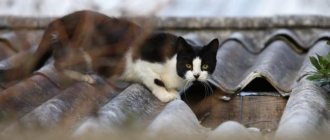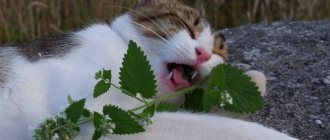Many cats are partial to indoor plants. Moreover, they often like to taste something that has an attractive smell to them. Sometimes owners don’t even think that plants growing on windowsills can become a real threat to the health and life of their pets.
Let's look at how plants are dangerous and which ones are completely poisonous for cats; Are flowers in bouquets dangerous? what are the symptoms of a cat leaving and how to provide first aid.
Common plants and flowers that are poisonous to cats
Many toxic plants are irritants: they cause local inflammation of the skin, mouth, stomach, etc. Toxic substances from other plants can have systemic effects and damage or alter the function of the cat's organs, such as the kidneys or heart.
Here is a list of some common plants that are toxic to cats:
- Amaryllis (Amaryllis spp.)
- Autumn crocus (Colchicum autumnale)
- Azaleas and rhododendrons (Rhododendron spp.)
- Castor bean (Ricinus communis)
- Chrysanthemum, chamomile, mother (Chrysanthemum spp.)
- Cyclamen (Cyclamen spp.)
- Daffodils, Daffodils (Narcissus spp.)
- Dieffenbachia spp.
- English ivy (Hedera helix)
- Hyacinth (Hyacintus orientalis)
- Kalanchoe (Kalanchoe spp.)
- Lily (Lilium sp.)
- Lily of the valley (Convallaria majalis)
- Marijuana (Cannabis sativa)
- Oleander (Nerium oleander)
- Peace lily (Spathiphyllum sp.)
- Pothos, Devil's Ivy (Epipremnum aureum)
- Sago palm (Cycas revoluta)
- Spanish thyme (Coleus ampoinicus)
- Tulip (Tulipa spp.)
- Yew (Taxus spp.)
Bouquets
Hyacinth (Hyacinthus)
pollen, leaves, stems, flowers, bulbs
toxic poisoning, impaired coordination of movements, heart failure
Iris, aka iris (Íris)
leaves, roots
vomiting, diarrhea
May lily of the valley (Convallaria majális)
vomiting, diarrhea
Calla lilies
contain oxalic acid,
irritation of the oral mucosa, laryngeal edema, impaired coordination of movements, acute heart failure
Lily (Lílium)
pollen
laryngeal edema, impaired coordination of movements, heart failure
Narcissus
leaves, flower stalks and bulb scales
vomiting, diarrhea, convulsions, heart and pulmonary failure
Snowdrops (Galanthus)
the entire plant, especially flowers and berries,
after the cut flowers stand in water, the poison ends up there too. Don't let cats drink from the vase. Flowers and berries cause allergic reactions, digestive system dysfunction, and even cardiac arrest.
Tulip (Túlipa)
pollen, bulbs, leaves,
toxic poisoning, impaired coordination of movements, heart failure, allergic dermatitis
Chrysanthemum
irritation of the oral mucosa, vomiting, diarrhea, convulsions, renal, cardiac and pulmonary failure, allergic dermatitis
What parts of the plant are toxic to cats?
If a plant is poisonous to cats, assume that all parts of the plant are poisonous, although some parts of the plant may have higher concentrations of the toxic substance than others.
Toxic doses can vary widely from plant to plant. In some cases, ingesting small amounts can have devastating results, while cats may require exposure to relatively large amounts of other plants before symptoms appear.
How to tell if a cat has been poisoned
The first symptoms indicating intoxication:
- poor appetite;
- impaired body movements;
- drying of mucous membranes;
- lethargy (the kitten loses interest in games, spends more time in solitude, often sleeps);
- difficulty breathing (wheezing may occur);
- paralysis;
- vomit;
- bowel dysfunction;
- increased salivation.
Each cat goes through this process differently. If in one case the symptoms appear several hours after ingestion of the harmful plant, then in another situation the poisoning is protracted and chronic. How quickly the consequences will be felt depends on the amount of weed eaten. You cannot do without medical intervention, because it is possible to completely cure a cat only with drug therapy or in an inpatient setting.
Symptoms to watch out for
Since many plants are irritants, most symptoms observed will be the result of irritation or inflammation, such as redness, swelling, or itching of the eyes, skin, or mouth.
When deeper parts of the gastrointestinal tract, such as the stomach and intestines, become irritated, vomiting and diarrhea are likely.
If a toxic principle directly affects a specific organ, the symptoms observed will be primarily associated with that organ.
For example:
- Difficulty breathing (if the airways are affected)
- Drooling or difficulty swallowing (if the mouth, throat, or esophagus is affected)
- Vomiting (if the stomach or small intestine is affected)
- Diarrhea (if small or large intestine is affected)
- Excessive drinking and urination (if kidney damage)
- Fast, slow, or irregular heartbeat and weakness (if the heart is affected)
Possible consequences
Contact with plants that are dangerous to cats can lead to various consequences. The negative influence of some colors can accumulate, causing the animal's health to deteriorate over time. Other plants can lead to serious poisoning and a sharp deterioration in the animal’s condition.
Symptoms of allergies caused by plants:
- tearfulness;
- nasal discharge;
- frequent sneezing;
- the appearance of inflammation on the skin;
- the animal constantly scratches one place (muzzle, withers or another).
If harmful components enter the body, the following symptoms may occur:
- increased salivation;
- diarrhea;
- nausea;
- decreased appetite;
- decline in activity.
In case of poisoning, the following symptoms are observed:
- frequent and severe vomiting (sometimes mixed with blood);
- diarrhea;
- significant increase in body temperature;
- complete loss of appetite;
- a sharp decline in activity, apathy.
In case of severe poisoning, the animal’s condition deteriorates sharply and quickly. Intoxication leads to disruption of internal organs, which can result in the death of the animal. This is why in case of poisoning you should immediately consult a doctor. Sometimes the hours count!
Immediate help
If you see your cat eating a plant and you are not sure whether it is poisonous, or even suspect that your cat has eaten such a plant, do the following before taking her to the vet:
- Remove all plant materials from your cat's fur, skin, and mouth if you can do so safely.
- Keep the cat in a safe environment for close monitoring.
Plant identification is very important in determining treatment. If you don't know the name of the poisonous plant your cat was exposed to, bring a sample of the plant or plant material that your cat vomited to your veterinarian's office.
Non-hazardous plants
There are plants that have a very unpleasant smell for cats. You can put them on the windowsill without fear, because your pet won’t even come near it.
We recommend the article: Coronavirus in cats. Symptoms Dangerous consequences.
Plants that your cat definitely won’t touch:
- lemongrass;
- mandarin;
- sheddock;
- kinkan;
- calamondin;
- panderosa;
- coleus canine (has an unpleasant odor not only for cats, but also for other animals).
Houseplants that are generally safe for cats:
- violet;
- chlorophytum;
- jasmine;
- camellia;
- begonia;
- dracaena;
- peperomia;
- arrowroot;
- indoor grapes;
- coleus;
- Venus flytrap.
It should be noted that these plants are safe for most cats. However, there remains a possibility that these plants may cause an allergic reaction in some animals.
Cat grass (sprouted oats) can be called not only a safe, but even a useful plant. Its seeds are sold in pet stores. It sprouts within a few days and does not require special care. Such grass will delight the owner with its beautiful greenery, but the cat will be able to chew it to its heart’s content, get all the necessary components and cleanse its stomach.
Vomiting after eating cat grass is not a sign of poisoning.
The following plants are also beneficial for cats:
- mint;
- thyme;
- cat mint;
- valerian;
- thyme;
- Melissa.
But it is worth remembering that the cat should not consume too much of these plants, otherwise an overdose or an allergic reaction is possible. Valerian and catnip are especially dangerous, as some cats react too zealously to their smell. These herbs can be dried and filled into cat toys.
Treatment
Your veterinarian may give your cat anti-vomiting medications and/or activated charcoal to absorb any toxic substances that may be in the intestines. Your veterinarian may also prescribe a treatment such as sucralfate, which protects the damaged areas of the stomach.
Supportive care such as intravenous fluids, anti-nausea medications, feline pain medications, and anti-inflammatory medications will be used as needed. Depending on the toxin and the cat's condition, other treatments may be needed.
What to do if your cat eats plants but doesn’t want to part with them
To stop your cat from chewing leaves, you can dilute a little lemon juice in water or infuse orange peels and spray the plant with the solution. The bright citrus aroma will scare away your pet, but in return you need to offer him special sprouted grass, ordinary millet or oats, which he can and should enjoy to his own pleasure.
Care
Ingestion of some poisonous plants can be fatal to cats, especially if treatment is delayed. Other plants can cause enough damage that long-term care in the form of medication or a special diet will be required.
Be sure to follow your veterinarian's instructions and ask any questions you may have.
Take all possible measures to protect your cat from exposure to poisonous plants. This includes removing such plants from the home and keeping the cat indoors or closely monitoring any outdoor activities.
How to save a flower without harming your cat
Owners do not always want to part with poisonous indoor plants and flowers for cats, especially with an expensive, rare species or a valuable gift. What to do without causing damage to the cat’s health? The following precautions will help:
- place pots with poisonous flowers on the top shelves or on cabinets where the animal will definitely not reach;
- periodically spray the leaves of the plants with lemon juice (any other citrus will do) or put the fruit slices/zest directly into the pot - cats don’t like strong fruity aromas, so they definitely won’t go near the pot;
- Another bitter “anti-rodent” will also work: for educational purposes, spray the stem and leaves with the liquid;
- Place cacti in smaller pots around the cat’s main “enemy” in a pot, thereby creating a “thorny fence” (however, there is still a risk of the cacti tipping over);
- treat the windowsill with vinegar solution;
- hang plants on special plastic holders for pots;
- leave flowers in the loggia without letting the kitten in;
- alternate plants, growing species with a persistent aroma (tangerine, coleus dog, kincan) next to dangerous flowers;
- protect from small kittens with thick curtains, through which the cats will not be able to get to the potty;
- development of a reflex - a radical method of weaning a pet from chewing leaves and stems, consists of spraying the cat with a spray bottle immediately after he starts chewing the greens (after a couple of weeks of such prevention, the cat will forget the way to the desired flower).
In order not to deprive your pet of the pleasure of eating greens, buy special grass for cats at the pet store. It grows all year round. At the same time, you will be calm about the animal’s well-being, and the kitten will receive a complex of necessary vitamins and will not harm your favorite flower.
Houseplants that are dangerous for pets.
Cats and dogs are curious animals, and indoor plants can also attract them, but not all of them are safe. In this article we will look at some plants that are dangerous for pets.
Pets do not know which plants are useful and which are deadly for them, so the owner’s task is to know dangerous plants and protect pets from them. Often plants that are dangerous to pets are also dangerous to children.
Before purchasing each new plant, if there are small children or pets in the house, you need to research whether it is poisonous.
Aroids (Araceae)
The poisonous juice of plants of this family contains the amino acid asparagine and calcium oxalate crystals, causing swelling of the larynx and oral mucosa, burning and blistering of the mucous membrane, respiratory arrest, and if it gets into the eyes, conjunctivitis and irreversible changes in the cornea, blindness; allergic dermatitis; disruption of the kidneys and heart.
- Dieffenbachia.
- Monstera
- Anthurium
- Spathiphyllum
- Caladium
- Philodendron
- Alocasia
- Aglaonema
- Calla (Zantedeschia) or spotted arum (Arum maculatum)
- Zamioculcas (Dollar Tree)
- Syngonium
Araliaceae
The juice and leaves contain saponin hederin, various toxic glycosides and alkaloids, cause irritation of the mucous membrane and gastrointestinal tract, depression of the heart muscle and can cause respiratory arrest.
- Hedera (ivy)
- Fatsia Japanese (Fatsia japonica)
- Polyscias
- Schefflera
- Fatshedera
Cutraceae (Apocynaceae)
Toxins have a nerve-paralytic effect, inhibit the functioning of the heart and lungs, and impair visual function.
- Oleander (Nerium oleander)
- Pachypodium
- Adenium obesum (Desert Rose)
- Mandevilla or Dipladenia
Colchicum (Colchicaceae)
Contains the alkaloid colchicine. Causes bleeding disorders and severe kidney damage.
- Gloriosa
- Colchicum (Colchicum, Autumn Crocus) (Colchicum)
Nightshades (Solanaceae)
The green parts of these plants contain the alkaloids solanine, some - atropine and scopolamine, therefore, when consumed internally, they can cause vomiting, salivation, clouding of consciousness, hallucinations, blurred vision, breathing, heart function, and paralysis.
- Solandra
- Solanum (Solanum capiscastrum, Solanum pseudocapsicum)
- Browallia
- Datura or Datura
- Belladonna (Atropa belladonna)
- Black henbane (Hyoscyamus niger)
Including physalis berries, potatoes and eggplants
Heathers (Ericaceae)
Contains the glycoside andromedotoxin, which causes poisoning if ingested. The poisonous nectar of flowers and the juice of leaves causes depression of the central nervous system, cardiac dysfunction, eating disorders, nasal discharge, and excessive salivation.
- Azalea (Rhododendron / Azalea).
Hydrangeaceae
Contains cyanide, causes severe abdominal pain, severe stomach upset, vomiting and diarrhea. In some cases, tremors, disturbances in the functioning of the heart, lungs and kidneys.
- Hydrangea (lat. Hydrangea)
Amaryllis (Amaryllis)
They contain the alkaloid lycorine, which causes abdominal pain, vomiting, salivation, diarrhea, and in large doses - tremors, paralysis, general collapse (acute vascular insufficiency, a sharp drop in vascular tone or a rapid decrease in the mass of circulating blood, which leads to a decrease in venous flow to the heart, drop in arterial and venous pressure, brain hypoxia and depression of vital functions of the body). The most dangerous are the bulbs. Rodents are at particular risk.
- Amaryllis
- Hippeastrum
- Zephyranthes
- Eucharis
- Valotta
- Clivia
Primroses (Primulaceae)
This family contains cyclamens and primroses, which contain the saponin cyclamine, which causes pain in the mouth and larynx, burns of the mucous membrane, and difficulty breathing.
- Cyclamen
- Primula
Euphorbiaceae or Euphorbiaceae
They contain euphorbine, poisoning with which occurs in a very severe form, causing long-term non-healing burns and ulcers of the oral cavity and pharynx, inflammation of the mucous membranes of the eyes (up to temporary blindness), dysfunction of the gastrointestinal tract with impaired nervous regulation, and allergic dermatitis.
- Poinsettia or Euphorbia beautiful, “Christmas star” (Euphorbia pulcherrima).
- Croton or Codiaeum.
- Euphorbia Milii, or crown of thorns milkweed (Euphorbia Milii)
- Euphorbia tirucalli
- Akalifa or "fox tail" (Acalypha)
- Castor bean (Ricinus communis). Beans are especially dangerous.
- Jatropha
Cut flowers
Some cut flowers and even the water they stand in can be dangerous to pets. Daffodils, snowdrops, irises, chrysanthemums, callas, lilies, tulips, hyacinths, lilies of the valley, lilacs, peonies, lupine, ranunculus, delphiniums, aquilegia, foxglove, periwinkle, asparagus, and gypsophila are poisonous. Therefore, under no circumstances should you allow a cat or dog to gnaw on plants from a bouquet, or drink water from a vase.
What to do in case of poisoning?
In case of poisoning, you need to remove toxic particles from the animal’s fur, skin and mucous membranes as soon as possible, rinse with plenty of water, if you suspect that the animal has swallowed a piece of the plant, induce vomiting, give activated charcoal and immediately contact a veterinarian. It is advisable to take a piece of the plant with you so that the doctor can determine the type of toxin and prescribe the appropriate treatment.
Dangerous plants should be removed from the house, or pets should not be allowed near them. You can place strong-smelling objects (citrus peels, spray with anti-rodent spray) or rustling foil on the windowsill. As an alternative, offer your pet specially grown grass: oats, wheat, rye, barley, catnip, bluegrass.
Rue - cats don't like its smell
Common rue grows up to a meter in height and its flowers are small and yellow. The plant is not used to decorate houses, but it is used in herbal medicine. However, this is not the only function that a regular root can perform. Cats don't like its smell, so many people grow it in the garden to scare away unwanted guests.
Is your home visited by your neighbors' pets and are you concerned about the health of your cats? Then take care of your health and get ordinary rue, which will scare off uninvited guests with its aroma. Lavender will work in a similar way, but not all cats will bypass it.
- Common rue is a plant that decorates gardens and is used in herbal medicine. Cats don't like its smell, so you can sow it on your property to deter intruders.
Plants containing soluble oxalates
Soluble oxalates are found in the leaves of many vegetable and ornamental crops, including amaranths, prickly pears, rhubarb, sorrel and beets.
Absorbed into the gastrointestinal tract, these substances bind to serum calcium oxalate and cause systemic hypocalcemia. Calcium oxalates are excreted from the body through the kidneys, causing acute nephron damage.
Such plants are dangerous for cats because they cause severe nephrosis with the deposition of oxalate crystals in the renal tubules, which is detected during histological examination of the kidneys.
Affected animals experience:
- weakness;
- lethargy;
- diarrhea;
- vomit;
- anorexia;
- hypersalivation.
24-36 hours after consuming dangerous plants, cats develop polyuria/polydipsia, oliguria, oxaluria and hematuria.
Laboratory tests reveal high levels of urea and low calcium levels in affected animals. Sometimes calcium oxalate crystals are found in the urine.
To remove toxins, the cat is vomited, and then given activated charcoal and laxatives. In case of hypocalcemia, the animal is prescribed calcium gluconate; in case of oxaluria and azotemia, infusion therapy is carried out. The affected cat is also given an antiemetic and kidney function is constantly monitored.
Onion and garlic
Raw onions and garlic contain di-propyl disulfide, and boiled garlic also contains sodium N-propyl thiosulfate. Under the influence of these oxidizing substances, hemoglobin in the blood is transformed into methemoglobin, which is unable to transport oxygen molecules to the tissues. As a result, animals develop hemolytic anemia with the formation of Heinz bodies.
The minimum toxic dose for cats that causes clinically significant changes in blood parameters is 5 g/kg body weight. The development of toxicosis can begin with both single and repeated consumption in quantities less than the toxic dose.
Onions and garlic are dangerous for cats, both raw and cooked. Within 24 hours after poisoning, animals develop:
- diarrhea;
- vomit;
- stomach ache;
- depression and anorexia.
After a few days, cats develop hemolytic anemia, accompanied by:
- rapid, shallow breathing;
- pallor or yellowness of mucous membranes;
- tachycardia;
- lethargy;
- weakness.
In some cases, cats with onion or garlic poisoning experience ataxia and darkening of the urine.
To make a diagnosis, animals are prescribed:
- Ultrasound of the abdominal cavity;
- Analysis of urine;
- clinical and biochemical blood test.
There is no specific antidote for poisoning with onion plants. To stop the absorption of toxins from the digestive system, affected cats are given sorbents. For onion and garlic poisoning, pets are prescribed ascorbic acid and acetylcysteine. In severe cases, a blood transfusion and stay in an oxygen chamber are necessary.
How can you use your cat's dislike of citrus fruits for beneficial purposes?
From the above, you have already understood that with the help of citrus essential oils you can wean your animal off unwanted things. Let's take a closer look at the options in which citrus fruits will help train your pet:
- If your cat does not go to the litter box, but does it in another place. If you are faced with such a situation, then you can apply citrus essential oils to the places where the cat relieves itself, and be sure that it will not go there again;
- If your cat often breaks furniture or chews wires. Many people think that this problem occurs only among those who have dogs. But, in fact, cat owners also face this problem. All you have to do is apply a few drops of essential oil on the furniture or wires and your problem will be solved;
- If your cat is marking territory. Those pet owners who have a cat know that at a young age these little furry friends constantly mark their territory, for example, corners, things, etc. This is a serious problem, because this smell is extremely difficult to remove. Therefore, if you want to get rid of such a problem or avoid its occurrence, then take note of this simple method;
But this method has several nuances. Firstly, the essential oil will quickly dissipate and its smell will not be felt, so you will have to repeat this procedure often until the pet learns to behave as expected. Secondly, there is a more serious problem such as allergies. Many pets cannot tolerate citrus odors and may suffer from them, so consider whether the risks are worth it and consult with your veterinarian to make sure your cat is not allergic.
How to stop a cat from chewing unsafe greens
To ensure that plants that are dangerous to domestic cats are harmless, you need to place them in inaccessible places: high shelves or niches. You can hang flowers in flower pots. It is better if such plants are located in an enclosed space, for example, a heated balcony, where the pet is not allowed access.
To satisfy your pet's need for greens, sprout oat or wheat seeds that contain beneficial substances. The sprouts sprout quite quickly, and to obtain a useful harvest you only need gauze, a saucer and water.
Vomiting after eating cat grass is not a symptom of poisoning!
Window sills, as well as the plants themselves, can be sprayed with a solution of lemon essential oil; it repels cats with a pungent odor. In the pet store today you can find sprays that dissuade animals from eating dangerous greens, but are not harmful to plants. They also use dried citrus peels, placing them in a pot or next to it, but this will not discourage persistent individuals.
As protection, they suggest using double-sided tape, sticking it next to plants and on pots. The cat will be disoriented, falling into the “trap”; in addition, the smell of the adhesive composition is unpleasant for four-legged animals.
Many owners use the reflex effect. To achieve it, you need to spray the plant hunter with a spray bottle every time he tries to attack green spaces. In this case, you need to act long and hard so that the relationship between these two actions is imprinted in the cat’s head.
A cat will appreciate grass grown especially for it.
Precautionary measures
If the owner does not know whether dracaena is poisonous or not for cats, then he does not need to grow this flower in the house. You should always remember which flowers are poisonous to cats and which are not. It is advisable to keep only non-poisonous plants in the house, such as arrowroot, roses, coleus, cacti, catnip, violets (but not uzambara), cereals, basil, mint, thyme, lettuce, parsley. If, after all, there is a dangerous flower in the apartment, then it must be placed in the most inaccessible place for the cat.
Following safety measures and choosing the right home flora is a great way to decorate your interior without harming your pet. But before buying, you need to read the description of the flower and check the prohibited list.

